Varicosis is a foot disease, which not only damages one's aesthetic appearance, but can also lead to some serious complications.The main cause, the symptoms and methods of treating varicose veins in the legs are described in detail later.
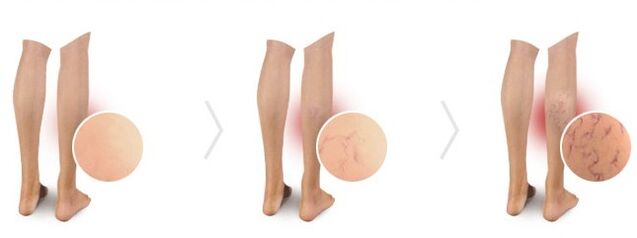
Medical Certificate - varicose veins
Varicose veins - chronic peripheral veins in the lower leg with progressive courses.It is characterized by the development of vein pathology, which is characterized by a violation of reverse blood flow in it due to the weakness of the valve and vessel wall.As a result, there is a venous blood and increased pressure on the veins, the walls that over time loss of elasticity and begin to stretch and change.According to international disease classification, ICD-10 varicose veins from the lower leg have 183 code.
Cause
The etiology of varicose veins is not well studied.Doctors consider polyethiological disease, but distinguish some developmental theories:
- Mechanical theory. Excessive burden on lower limbs: with standing work (surgeon, dentist, teacher, hairdresser), athlete, pregnant woman.
- Neuroendocrine Theory. Due to the transition of hormones (pregnancy, menopause, sexual cooking), the blood vessel wall tone is reduced.
- Genetic predisposition.Determination of congenital function of the valve in the vein.
Risk factors for the development of varicose veins:
- female gender;
- descendants;
- Overweight;
- load load;
- An inactive lifestyle.

Symptoms of disease
The manifestation of the disease is:
- The appearance of vascular mesh in the form of stars on the skin is telangioectasia.
- Skin changes: dryness, pigmentation.In later stages - dermatitis, eczema, trophic ulcer.
- Features that bulking through the veins can be used in the lower leg.
- The appearance of pain and discomfort in the foot, especially after physical work.Pain can have different characters (pulses, burns, pain), time of occurrence (pain during walking, at the end of the day, at night).
- The development of edema and calf muscle seizures.Initially, swelling was observed in the foot region, then applied to the lower leg.
The level of development of varicose veins
The disease develops gradually and slowly.It can pass for several years when the first symptoms appear.
- Stage 0. It is characterized by non -specific features, such as severity and discomfort in the foot that can be symptoms and other diseases (osteochondrosis, flat feet).At this stage, the disease is also difficult to diagnose due to the lack of major attributes and advanced vein performances.
- Stage 1. Changes on the skin - the vascular stars are attached to the above complaints.
- Stage 2. Swollen veins and enlarged winding, nodules are characteristic.
- Stage 3. The events of edema are mainly mentioned at the end of the day.
- Stage 4. It is characterized by irreversible changes in blood vessels and trophic lesions due to affected blood circulation and inadequate tissue nutrition.Strong skin pigmentation (dark brown) is a feature.
- Stage 5. Trophic ulcer healing.
- Level 6. Trophic ulcer does not speak.
The possibility of complications
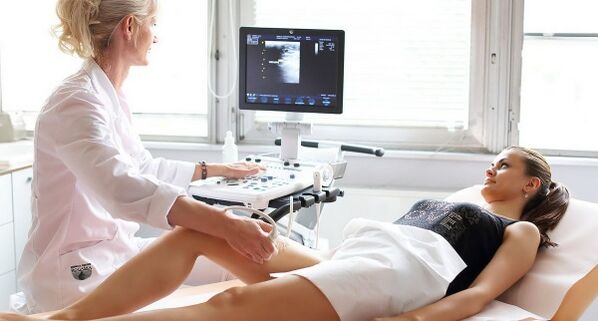
The disease itself is not harmful to survival, but its complications are dangerous due to short or improper treatment:
- Acute thrombophlebitis Surface vein - inflammation of the blood vessel wall, the formation of blood clots from blood clots, which leads to blood circulation in the tissue;
- Pulmonary artery thromboembolism - blockage of pulmonary artery lumen with thrombus, which separates from the vessel wall, often has death;
- Phlebotrombosis;
- Trophic ulcer - occurs with a form of developed varicose veins due to poor blood tissue nutrition;
- Bleeding from nodes.
When to see a doctor
Varicose veins are diagnosed and treated by phlebologists (cardiovascular surgery).In order not to miss the onset of the disease, it is necessary to contact the specialist at the first signs:
- the appearance of vascular stars on the feet;
- feeling discomfort in the leg, pain;
- swelling and rapid fatigue;
- Night seizures;
- The veins are significantly expanded.
Varicose veins in the feet, timely and effective treatment, less threatening complications.
Steps -The diagnostic step
To date, the main diagnostic method is ultrasound.When diagnosing varicose veins, these steps are carried out:
- Ultrasound Dopplerography. Methods that combine the use of ultrasonic and doppler diagnostics and allow you to evaluate the properties of blood through vessels, presence of reverse blood, blood clots, cut -off vessels, venous valve surgery (presence of flotation), and peripheral patency and in the veins.There are several types: color dopplerography, duplex dopplerography and triplex.
- Duplex scanning (sonography) is a type of ultrasonic dopplerography, where 2 methods are used: dopplerography in mode and color.Allows you to determine the presence of blood clots, size, location properties, possible separation.This method does not attack, with high accuracy establishing a diagnosis and determining further treatment tactics.
- Phlebomanometry - a method for determining blood pressure on the vein wall.
- Phleboscintigraphy - the introduction of radiopharmacy to Vienna and observation using a special device.This method is used for combination of veins and lymph systems.
- Phlebography is a radiological method that implies the introduction of intravenous X -ray contract.In picture X -ray, the doctor will evaluate the condition of the veins.Ideal for deep vein diagnosis, when ultrasound dopplerography is wrapped.
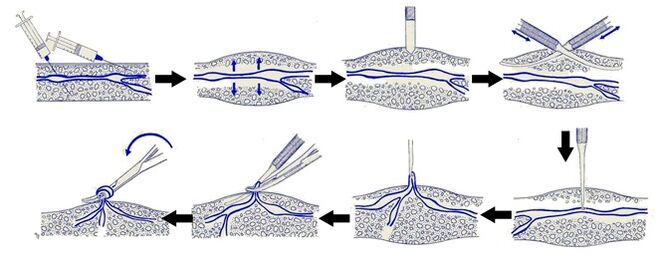
The last two methods are invasive, have several contraindications (allergies to contrast medium) and today are rarely used for diagnostic purposes.
Method of treatment
Varicose veins in the feet, treatment performed by two main methods in the complex (conservative and surgery), have good predictions.Conservative Methods:
- drug treatment;
- the use of traditional medicine;
- physiotherapy;
- Compression therapy involves the use of special pants;
- sclerotherapy.
Methods of surgery:
- Varadi operation - removal of affected veins (phlebectomy);
- Freezing laser veins.
External treatment with creams, ointments and gels
External use of creams, ointments and gels acts as an additional method in the early stages of the disease.Preparation helps reduce swelling, pain, improves venous wall tone.
Laser treatment
Lazamaria treatment (laser or ablation) is a minimum invasive method used in the form of a mentioned disease.Use lasers with different wavelengths.The laser light is inserted into the vein lumen and attaches the wall.In the future, such veins will solve it.This procedure occurs under the control of the ultrasound, leaving not after a strong bruise. Advantages of laser treatment: lack of recovery period, pain and safety of procedures, minimum post -operative complications, scars and pigmentation.
Sclerotherapy
Sclerotherapy - is the introduction of a special drug (sclerosant) into the affected vein, which attaches it from the inside and it disappears over time.There are several types of these methodologies: echo-sclerotherapy, microsclerotherapy.The procedure lasts for 20 minutes, a sclerotherapy session is required from 3 to 5. This method of treatment is widely used in many countries in the world and produces long results, and in the early stages of life.However, in a developed and severe form, sclerotherapy does not guarantee one hundred percent.
Hydrotherapy
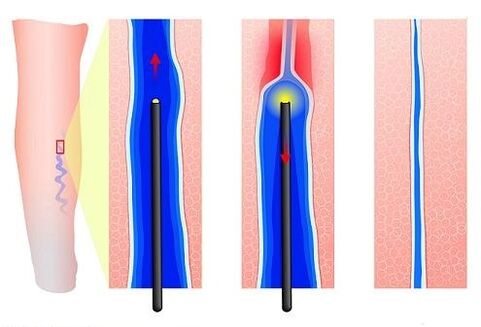
Hydrotherapy treatment (water therapy) in the form of various types of baths (with herbs, salts) and shower (round, massage, contrast) contributes to reducing blood vessels, helping to relieve fatigue and swelling of the foot.
The use of stockings and tights from varicose veins
The use of compression linen (tightening) helps in the early stages of varicose veins by eliminating blood stagnation in the peripheral veins and redistributing from expanded vessels to healthy ones. The use of such knit linen is possible for prevention and during recovery.
Surgical therapy
The removal of affected vein surgery - phlebectomy is a radical, complex, but most effective (almost 100% healing) method.However, phlebectomy has several contraindications: diseases of the cardiovascular system, liver, kidneys, pregnancy.After surgery, for a month, you should wear compression linens that slow down or apply elastic bandages to the feet.
Physiotherapy
The treatment of varicose veins with physiotherapy methods is effective for prevention, in the early stages of the disease, as well as in complex therapy.Widely used: laser therapy, darsonvalization, magnetic laser therapy, pneumocompression, uhf, balneo and mudrapy.Physiotherapy helps strengthen the blood vessel wall, improves valve operation, micro circulation and lymphokide in the limbs.The results that can be seen are achieved by regular course treatment in combination with other therapy methods.
The recovery of the people
Treatment with varicose vein remedies in the foot is widely popular in patients.However, keep in mind that all non -traditional drug methods are ineffective in the form of severe illnesses.People's recovery for the treatment of varicose veins:
- Tinctures herbal medicine: kalanchoe, noodles, horse chestnut, ginseng root, nutmeg;
- lotions and compression made of clay, honey;
- soda bath, sea salt;
- ointment (Vishnevsky);
- Hirudotherapy (treatment with medical leeches).
Using apple cari vinegar
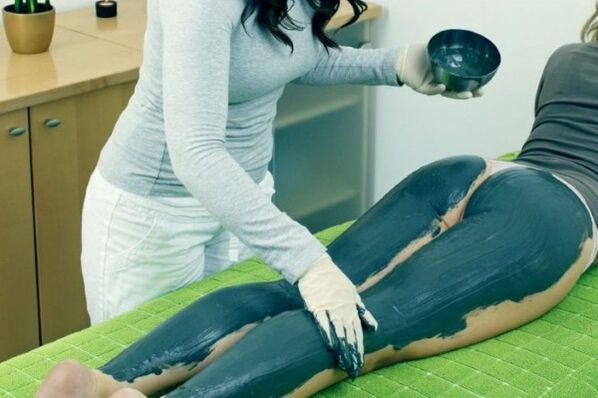
The use of apple vinegar for the treatment of varicose veins is recommended by many experts.It is advisable to cook the product itself, and not buy at the store.To prepare vinegar, you need to grind sweet apples, then pour 3 cm on warm water.Leave the product to plant for 2 weeks, sometimes stirring with a wooden spoon.Tension and add a few tablespoons to a glass of water to rub.Vinegar can be rubbed into sore skin, compression, wrap, bath.It strengthens the vein wall, improves blood circulation, reduces swelling.
Using lotions and clay
Blue clay in the form of lotions and compression is often used for preventive purposes and with early manifestations of varicose veins. Put the powder diluted with warm water with a thick layer on your feet, wrap it with a cling and wrap with a warm scarf.Keep the application for 40 minutes.Or apply for 30 minutes to gauze affected by gauze, launched with clay with minced garlic.Such therapies with normal use (2-3 weeks' courses) effectively relieve discomfort in the feet, swelling and fatigue.
Using Acacia Flower Tincture
For the treatment of varicose veins, white acacia colors are used.To prepare it, you need to fill the raw material in a 3 -liter jar and pour 0.5 liters of vodka and medical alcohol at 1/3, cover with lid.Assist the mixture in a dark place for two weeks.Lubricating sore feet with tincture finish 5-7 times a day.Tincture will help reduce the symptoms of varicose veins.
Using ginseng tincture
Ginseng root is a natural tonic for strengthening the vessel.Ready -to -buy tincture can be purchased at a pharmacy or provided freely with a 0.5 liter vodka 150 g crushed dried ginseng.Emphasize the liquid in a dark place for 2 weeks.Tincture to get into an empty stomach 1-2 tablespoons 4 times a day.
Using nettle
Nettles healing features have long been known.This plant improves blood circulation, prevents blood stagnation, strengthens the blood vessel wall.To prepare nettle therapeutic stew, fresh or dried leaves pour one liter of boiling water.Give a few hours and tension.For a month, drink a third of the glass 3 times a day.
Using potatoes
Effectively, the use of potatoes for varicose veins in compression, lotion.For compress, mix the newly launched tuber with a spoonful of honey and apply it to the sore area, finish with the film and bandage on top. Keep the compress for 5 hours and wash with warm water.The course of treatment is 3 weeks. Compression helps eliminate swelling, pain, vascular nets in the feet.
Prevention of varicose veins

To prevent the development of varicose veins, it should observe the following steps, especially those at risk:
- Keep normal weight;
- Avoid prolonged standing;
- Walking over walking, doing foot exercises;
- Limit wearing high shoes;
- Limit the use of alcohol and cigarettes;
- engaged in several types of sports (swimming, biking, aerobic);
- water procedures (different baths, relaxing baths for feet);
- wear compression underwear;
- Adhere to proper nutrition.
Varicose veins in the feet - treatment and diagnosis - an important component of a speedy recovery.To date, there are several non -traditional medicines and methods that promise to eliminate varicose veins.
If the varicose veins in the feet are not ignored, and start treatment on time, then there is a high percentage of good prognosis.In the early stages, conservative therapy is indicated: medicines, creams, compression knitwear, physiotherapy, traditional medicine recipes.In the specified form - laser ablation, removal of advanced veins.

















